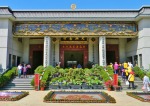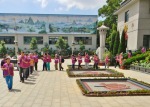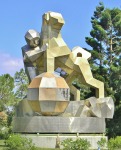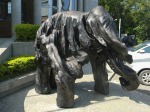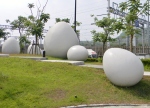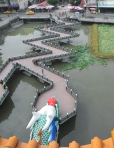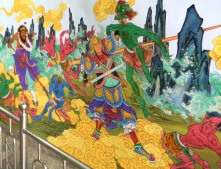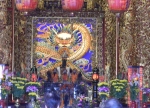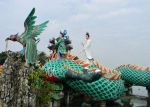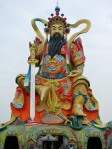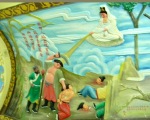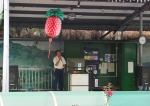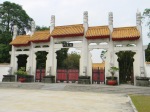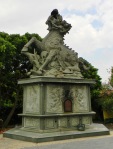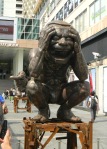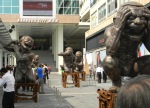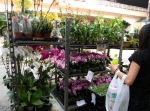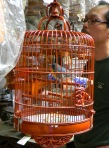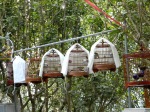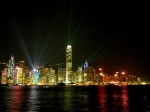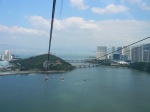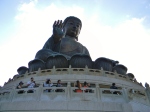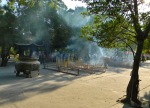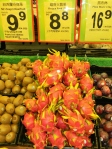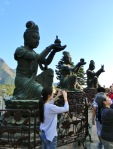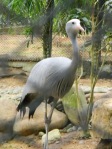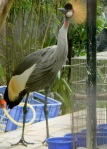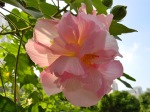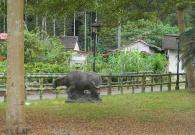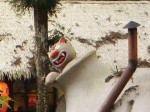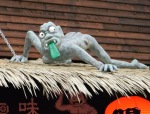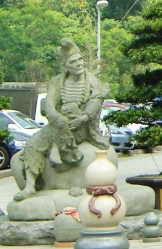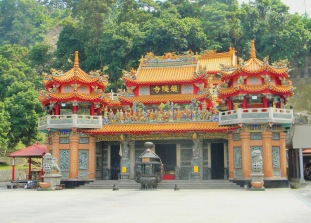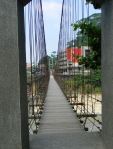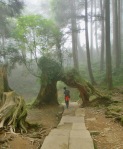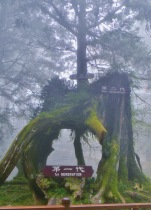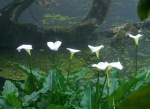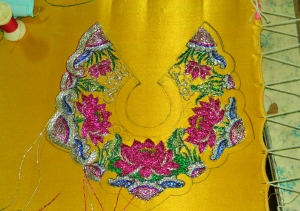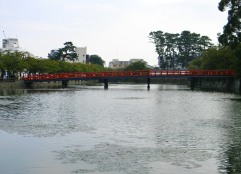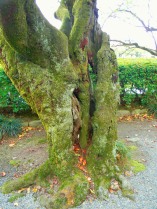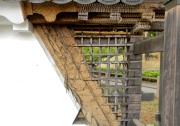Since I’m home right now, I thought it might be a good time to catch up on some things that I should have written about before. Like the trip to Sanyi, Taiwan last fall.
Before we headed into the town itself we visited a temple whose name I have no idea of. But the place was impressive, as they almost always are. They were undergoing some renovations, so the front gate had building supplies piled all around it, but that’s the price of progress, right? I wish I had gotten the name of the place, but language difficulties prevented a whole lot of detailed talking. The place seemed fairly new, as temples in Taiwan go, but it’s really hard to tell. I heard someone estimate that there are over 30,000 temples in this small island nation. Plus, they’re building new ones all the time. And the new ones seem to look just like the old ones in many cases.
There was this adorable sculpture just inside the main gate of a giant gold teapot, continuously pouring tea and a bunch of kids lighting firecrackers. So cute! Also quite large. The kids were more than life-sized. We then walked up a lovely marble staircase with large metal lotus blossoms on the top of each post. As we turned the corner at the top of the stairs, the main temple came into view. The courtyard had large, marble lotus blossoms in the pavement. The stairways and front were surrounded by flower gardens. There were many worshipers inside, I have no idea which deity the place was dedicated to. But there were a whole lot of people volunteering to keep this place going. (Hmmmm, kind of sounds like the church I go to, in that last regard.)
As we were standing in front of the temple, a bunch of people came out of the temple wearing purple vests. One of them had a bullhorn, the rest were carrying what appeared to be fake purple lotus blossoms. They all lined up in front of the temple for some kind of ceremony, while we continued on around behind the temple to view the rest of the grounds. The temple serves a free meal to all who visit and there were lots and lots of volunteers sitting around preparing the fruits and veggies that go into the feeding of the masses. I have no idea what most of the plant-life was, it was not stuff I was at all familiar with. Well, except for bamboo. Bamboo is cooked into a lot of things in Asia. There were many, many tarps laid out in the courtyard with bamboo slices on them, drying.
There was a lot of lovely landscaping around the temple grounds, huge pots of water lilies and a hillside covered with greenery and fake cranes cavorting about. We then came to the place where all that food we had seen being prepared was being served. It was pretty amazing to see how-oiled the machinery was that managed to feed hundreds of the visiting faithful (and just plain tourists!) each day (no, we didn’t eat there. We had just finished lunch shortly before arriving at the temple.) At the back of the hall there was an enormous block of jade, maybe 4 by 8 feet. It was carved with dozens of horses on each side, galloping across its face…both faces. Truly inspiring. Fabulous work!
After that it was a stroll back to the parking lot and a second viewing of some of the great statuary at the front of the grounds (they’re really into realistic anatomical detail on their horned lions! Uh, the horns were on their heads, but they were most decidedly male lions…). Then it was back to the parking lot and on to Sanyi itself.
Sanyi is known for wood carving. They host an international wood-carving festival and it truly is international, entered by carvers from a lot of different countries. I know this because we visited the wood carving museum there and saw some of the past year’s entries. But I’m getting ahead of myself.
This was another trip where friends of my brother’s drove us up to a special place we wanted to see. As I recall, the drive up was quite nice, but I was impressed with the town the moment we got to the edge of it. There was a great piece of sculpture as soon as we got off the freeway. Good start!
Then it was on to main street, store after store of (primarily) carved wood. (Surprise!) However, we didn’t start our visit to Sanyi there. Instead we went to a street that led to the wood-carving museum. This street was full of all kinds of stores selling artistic-type stuff, including some pretty incredible sculpture, in wood and stone. Pieces that were several thousand US dollars….and worth every penny. I was blown away by some of the things I saw in those stores. These were not your average something-for-a-tourist-to-take-home stores.
After visiting a few of these stores we went up to the museum. Outside were two sculptures of elephants. made of something that looked like giant pieces of driftwood, although it probably wasn’t. Unless it drifted in off some really giant trees! The museum was great, unfortunately they didn’t allow cameras. Which was totally not cool, because the stuff was awesome. But what can you do?
After some time in the museum, we cruised the high-end tchotchkes on the avenue again for a little while, then we went to an art gallery that the woman who was with us apparently frequents fairly often. They seemed to know her quite well. Which means she has really, really excellent taste in art because the stuff in the gallery absolutely blew me away. There was one piece in particular that I seriously considered tapping out my IRA to own. It just made me feel that free and alive. I think we ended up spending more time at the gallery than we did at the museum. And it was worth every minute.
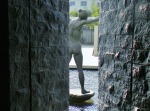
I know I should have written about Sanyi closer to the event, when things were still fresh and the details were…there. Still with me. But I didn’t. The big things though, the highlights, they’re still there. The flavors of the place. Standing before one of the infinity pools at the gallery, looking at the mountains in the distance, soaring on the feeling of airiness and space. Or looking in the other direction and watching the people having lunch in the courtyard, with striped bamboo all around them; the sing-song of their voices and the ring of their laughter. I almost hated to leave, but we had yet to walk through any of the stores we passed on the way into town.
That, unfortunately, was a bit of a disappointment. The prices of goods in these stores had become what I have come to call “Americanized”. The prices are no longer what the average Taiwanese would pay, but are based on what the average American tourist would be willing to pay. Which I wasn’t. I left disappointed with no memento of Sanyi in my bag. Just my photos and memories, which are far more important than “stuff” anyway.
On the way out of town there was a fence alongside the road. Someone had planted a flowering vine across the top of it, then trained it to undulate along the fence top. As we reached the end of the fence, I saw that they had carved the end of the vine into the head of a serpent. A half-mile long snake. Unfortunately, that picture didn’t come out. Too bad. But still, a lovely day in Sanyi.


